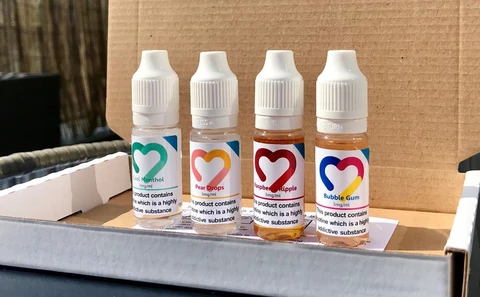
E-liquid is as old as vaping itself, it's obviously a fundamental part of vaping. But in the earliest days of e-cigarette use e-liquid was just an unnamed component of the first vaping products.
The first e-cigarette I ever experienced personally was a 'cig-a-like' that contained very little e-liquid and produced very little vapour. I had no idea what was inside the plastic tube, I had no idea what was producing the 'smoke', and when it ran out it was time to throw it away and buy another one.
This was a few years before I eventually quit smoking and by the time I did refillable tanks were the norm. The knowledge people have about vaping has grown very quickly, thanks in most part to businesses owned by fellow vapers, online communities and their willingness to help others and share information. Most people now understand exactly what is in e-liquids; and if they don't know it's fairly easy to find out.
Cig-a-like e-cigarette devices at the birth of the vaping industry
That little 'cig-a-like' I tried was bought from a motorway service station, it wasn't very good at all. There was a choice of two flavours, one was supposed to be an American toasted style tobacco, one was a menthol tobacco. There was no choice of strength and each replaceable section of the e-cigarette was meant to contain the equivalent of 10 cigarettes. At the price I paid, there was no money saving incentive to switch to this product. It did get me through a long car journey without having to stop all the time for 'smoke breaks' though, which is what I would do when I had my kids in the car.
While it wasn't effective enough for me to quit smoking for good that day, it did plant a seed in my head that this e-cigarette technology could work in the future.
New e-cigarette devices with refillable tanks
That future quickly came a reality when less expensive, refillable vaping devices hit the market. Compared to today's standards they were still very limited but the idea of having a device and a small bottle of e-liquid to refill it with as many times as you liked was appealing. Not only that but we now had access to a variety of basic flavours and nicotine strengths. Due to the design of these early vaping devices VG/PG ratios were fairly standard at 50% PG or 60% PG and most people didn't even consider the ratio as important. The liquids were designed to work with the common devices and they were simple low power MTL devices. There was was no real consumer demand for higher VG content in e-liquids. That however, would be about to change.
High VG content e-liquids
Better technology and the demand for a wider variety of vaping experiences exploded the vaping industry in all directions. Multi-layered flavours produced by combining many different flavourings, VG content from 50% all the way to 90% VG or more, the choice and options of vaping e-liquids were suddenly huge realm to explore.

Larger tanks and mods able to deliver more power, combined with a desire for more vapour production, meant higher VG liquids became a huge market and for a while it felt that a new e-liquid brand was on the market everyday. Looking back it certainly felt like the industries heyday and a great many people made hay while the sun was shining, although it didn't take long for darker clouds to start appearing.
Growth of an unregulated vaping industry
A number of things happened during this period that were unacceptable to me. As the industry was still completely unregulated it was not far off the wild west in vaping land.
Some companies, although I hate to call them companies as that has connotations of professionalism, were found to be producing e-liquids in less than ideal conditions. Other companies were adding vitamins (extra healthy vaping!), caffeine (for that morning wake up vape), and other substances to liquids and trying to make that a selling point, a novelty to make them stand out in an ever increasingly crowded market.
This was all almost unanimously rejected by consumers thankfully. I don't know if this was just a relatively new product finding its feet or something more cynical and exploitative by the manufacturers, but when the TPD (Tobacco Product Directive) regulations hit the UK 4 years ago, many of us were not surprised and a lot of vape consumers welcomed the news that some kind of sensible regulation of the vaping market was coming soon. Unfortunately, when details started to emerged most vapers were not impressed by the incoming laws that would negatively effect both consumers and manufacturers.
Introduction of TPD (Tobacco Product Directive)
I won't go into too much detail about the TPD regulations as many of you will know them, some of you might not even remember a time before them. What I do want to touch on though was the astronomical cost to manufacturers here in the UK.
We had a number of casualties, some of the smaller (but very good) e-liquid manufacturers just could not afford the costs incurred, or refused to make such a massive investment with an uncertain future. New labels, packaging, bottles, testing and a long list of other costs related to compliance. It was a hugely difficult time for everyone. The guidelines were vague in places and difficult to understand. The TPD changed a lot of things in manufacturing, but as consumers we could no longer buy anything larger than a 10ml bottle of e-liquid with nicotine in, we could no longer buy e-liquid that contained over 20mg of nicotine.
Along came short-filled e-liquid bottles
Short filled e-liquid bottles and nicotine shots were the answer for many as liquids not containing nicotine are completely outside of the scope of the TPD, but that only went some way to being a solution. If you use 12mg or 18mg e-liquid then they were useless with 20mg nicotine shots. Still now I speak to confused new vapers asking “I need 12mg liquid, how can I make this bottle 12mg” and the simple short answer is you can't... legally. Thankfully for people like me the popularity of pod systems and smaller devices also meant a continued need for higher nicotine liquids, so the existing market and a lot of new vapers using this type of device demanded that they continued to be produced.
The future for e-liquids
The future of e-liquid looks quite uncertain to me right now. It's very difficult to know where we will be in a few years. But being outside of the EU next year might give us a chance to form good, sensible regulations and maybe change some of the regulations that aren't working for the best interests of vapers, manufacturers and especially smokers. That could be a silver lining for us in the UK while the rest of the world is looking to impose flavour bans and worse.
I read in my paper the other day that smoking has been increasing over the last couple of months, it's not surprising with what is going on and I can't imagine this is a good time to be thinking about quitting either. Stay safe, look after each other and stay away from the stinkies, we'll get back to encouraging others soon... when the country is in a better place.
